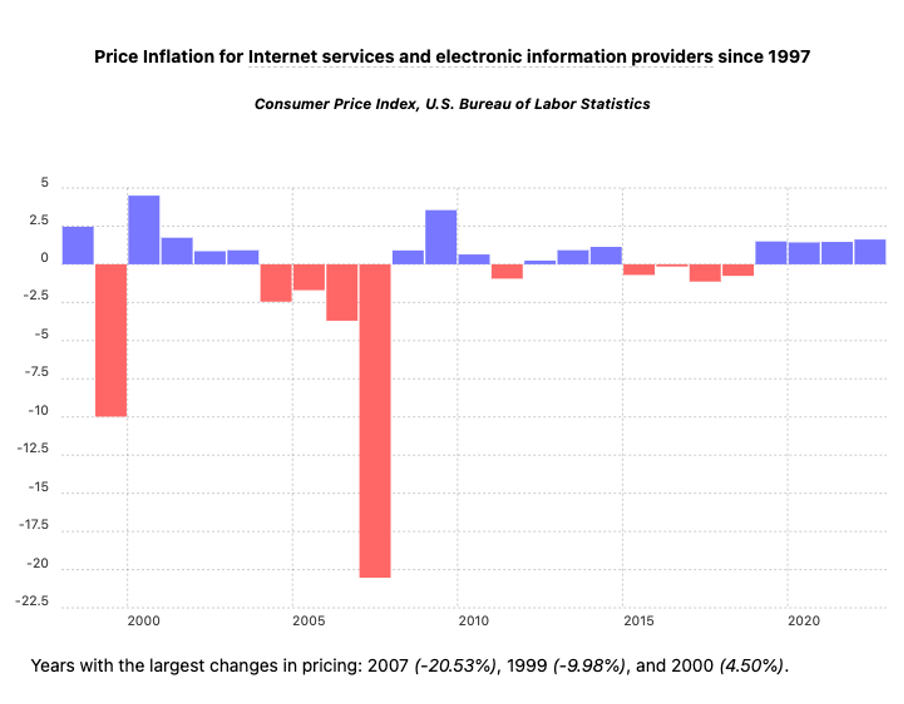We use it every day, but have you ever thought about the economics of the internet and its infrastructure.
Just thirty years ago, there was hardly any economic activity on the internet, which was used to send small data packages between individual users over dialup (The same network as your gran’s landline phone). Now the internet is a mega way of traffic with tens of millions of people streaming at any instant, and we are no longer tolerant of delays. The development of the infrastructure to support this has led to and is integral in the continued prospering of many emergent industries. These range from cryptocurrency, ride-sharing apps, streaming services, and online retailers. All this while also providing immense efficiency savings in administrative processes from general research and development to the provision of government services. There isn’t an industry the internet does not have a hand in today, and all told is thought to contribute US$2.1 trillion to the United States’ US$20.5 trillion yearly GDP, according to a 2019 study from the American Internet Association.

So how does the internet work:
To explain this, I will use a simple example of you accessing News.com from your laptop. On your laptop, you have access to an ISP (Internet Service Provider) which connects your device to the physical infrastructure that carries data. The ISP takes your request to the name server, in this case, News.com, and News.com responds by sending back the requested information to the ISP, which is transmitted to your laptop’s IP address and rendered into a form that you can use. The ISP connects to the name server in two ways.
The first option is the simplest. If the user and the server contract with the same internet service provider, then the data can be requested and delivered within the network of a single ISP.
The standard option is to reroute a user request from the name server to geographically distributed networks of servers near users like you called content delivery networks (CDN’s). Sometimes this is called “moving data to the edge of the network.” Because such networks are physically close to users by relocating the name address content, CDNs reduce the response while not requiring the name server and user to be within the same ISP network.
Both methods require massive infrastructure with significant overhead and maintenance costs. CDN’s often are comprised of office building-sized servers, and an extensive network of underground fibre or telephone wire is required to connect between networks traversing across countries and the oceans.
Several market transactions allow this to happen:
Several market transactions allow this to happen:
- Users typically pay ISPs monthly to connect customers using infrastructure ranging from ADSL and Fibre optic cable to satellite or other wireless options. This includes companies like Telstra and Optus.
- The owners of domain names (In this example News.com) pay server firms to provide them with a name server which stores their content and allows users to access it. These include companies such as Cloudflare and AWS.
- There are transactions between ISPs who share networks to increase coverage and decrease congestion.
Given the importance of internet infrastructure, is it safe in the hands of the private sector?
Naturally, carriers have incentives to build more lines, improve existing infrastructure to make more connections, and relieve congestion, which helps the firm gain revenue and reduce costs (By increasing their customer capacity and service desirability). These incentives are consistent with the desirable long-term objective of more efficient internet access and better options for routes to send and receive data in line with demand. This analysis has held over time, as shown in the below graphic, which graphs the inflation of internet services each year from 1997 to 2021, tracking a net decrease in prices of 20% (not corrected for inflation), while users now have access to connection speed multiple times faster today.

Beyond this, an interesting question regarding whether the internet is ‘safe’ in the hands of the private sector is the balance between private incentives to infrastructure improvement compared to gains in the network (i.e., the internet apparatus as a whole). For example, transit lines, improvements to them confer benefits to all the other complementary components. Do most of the gains from better transit lines go to the content providers who use them, the users who enjoy faster content, or the internet service providers who may gain revenue from users for better services?
The consensus is that improvements benefit more participants than just the firm providing this access. While access providers potentially gain more revenue, users gain better service, and application providers get the opportunity of new frontier tech for their data-intensive services such as streaming and more immersive products as we track further into the world of virtual reality. The gains from improvement are widespread, while the private costs and commercial risks are concentrated in the one investor group. I worry that the comparatively small private incentive to upgrade quality may eventuate in a large gap between service capability and society’s broader long-term interest, as the providers do not necessarily stand to benefit financially from large improvements as potential gains would be severely undermined by a spiked cost to cover development combined with a high degree of substitutability between internet providers. As such private based infrastructure possibly inhibits the development of internet services which would dramatically increase the economy’s productivity. This discrepancy in incentives and how to overcome it remains an open research area at the forefront of public policy. Finally, rural access is regarded as the key concern in the private provision of internet services. It is such an economic challenge that rural communities in the decidedly first world and affluent nations such as Australia and the US have less internet access than low-income families from a dense city in a developing country. For example, ten per cent of the rural US population still does not use the internet today. This is largely driven by a lack of access due to pricing or availability evident in a 2019 A Pew Research survey conducted in February 2019 which found that 46 percent of the US rural population does not have broadband access.

This shortfall in supply arises because the viability of internet service to given geographic areas relies on the efficiencies of economies of scale. Thus, operating cell towers, data centres, and content delivery networks (CDNs) exist endogenously in densely located areas. Further laying lines between locations involves high fixed and marginal costs, so low density may not have sufficient demand to induce such investments.
Further demand for better quality enterprise level services from densely located areas due to often professional service heavy local economies further incentivises this disparity. This is because providers prefer more locations where more buyers are willing to pay for the expensive frontier quality. This has a perverse effect as access to these services often contributes positively to an area’s productivity and general wealth, providing an excellent example of Marshallian agglomeration.
Many things have been tried to alleviate this. For example, the US passed the 1996 Telecom Act which established the e-rate program, which taxed telephone calls to finance subsidies for rural broadband, while Australia has its recent Nbn Program, which will when complete provide fibre coverage to most of Australia bar a few regional areas which will use satellite and fixed wireless technologies.